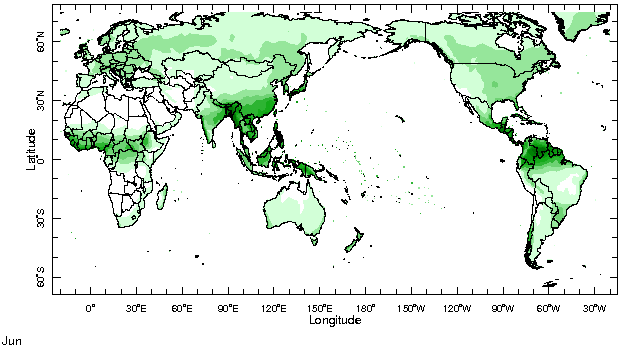|
IRI Climate Digest
July 2004
June Global Climate Summary
Climatological Background
In June, the sun's maximum northward location is achieved at 23.6 degrees north. Surface heating of the continents has initiated summer monsoonal systems or northern hemisphere warm season rains. In the southern hemisphere, winter is setting in with fewer daylight hours and cooler temperatures. The southern parts of South Africa, Australia, and South America are now in the path of mid latitude storm tracks.
Monthly Mean Temperature (1961-1990), data from the Climate Research
Unit, University of East Anglia


Monthly Mean Precipitation (1961-1990), data from the Climate Research
Unit, University of East Anglia


Temperatures
Highlights
During June, most of eastern and southern South America experienced higher-than-average temperatures, which was in stark contrast to the below-normal temperatures seen during May across southern South America. North America exhibited a similar temperature pattern as that observed in May, with above-normal temperatures in Alaska and western Canada and below-normal conditions in central Canada and the Great Plains of the United States. The cooler-than-average conditions in Siberia also reflected those observed during May in that region. Across the rest of the globe, western Europe, northwestern Africa, and much of Australia experienced above-average temperatures. Cooler-than-average conditions in portions of northeastern Europe and northern India were consistent with the above-average precipitation observed in those regions during June.
Temperature Difference from the 1961-1990 mean, with data
from NCEP Climate Prediction Center, CAMS.


Precipitation
Highlights
The beginning of the rainy season in the West African Sahel has been mixed. Areas of Senegal, Mali, and Burkina Faso received above-normal precipitation in June. Further south, above-normal precipitation also fell in Benin and western Nigeria, but conditions were quite dry in Cote d'Ivoire. Below-normal rainfall continued in the Great Lakes region of East Africa. In South Asia, although much of central and southern India was relatively dry in June, above-normal precipitation near the middle of the month, particularly in the Ganges and Brahmaputra River basins, led to extensive flooding in northeastern India, Nepal, and Bangladesh. Heavy rains continued in southern China and caused destructive flooding and landslides. Several typhoons in June, including two super typhoons, contributed to the abundant rainfall found over an extensive area of the western Pacific. Showers and thunderstorms produced heavy rainfall in the southern Plains and lower Mississippi Valley of the United States, and a series of tropical waves caused flooding in central and eastern Nicaragua.
Precipitation Difference from 1979-1995 mean, with data
from NCEP Climate Prediction Center, CAMS-OPI.


Oceanic Conditions
Tropical Pacific: Warmer-than-average conditions in the western Pacific warm pool and around Indonesia, and cooler-than-average conditions in the eastern Pacific cold tongue and along the coasts of Ecuador and Peru persisted during June, strengthening the climatological gradient, but were damped compared to those observed during May. See the latest IRI ENSO Update for a detailed summary and outlook.
Tropical Atlantic: Below-average SSTs persisted in the eastern equatorial Atlantic, while above-average SSTs dominated the western basin, extending along the South American coast between 10°S and 30°S.
Indian Ocean: Below-average SSTs strengthened along the East African coast, from Madagascar to the Arabian Sea, while weaker above-average conditions dominated the central equatorial basin, between 60°E and 100°E.
Extratropical Oceans:In the North Atlantic and eastern North Pacific, warmer-than-average conditions moved northeastward and then westward in a "horseshoe pattern", which is typical of this time of the year, with relatively cool conditions in the center. In the western North Pacific very warm conditions dominated the region of the Kuroshio extension, around 40°N. The central South Pacific, between 180° and 140°W, witnessed the persistence of above-average SSTs. In the western South Atlantic the meridional gradient strengthened, due to the contribution of warmer-than-average sub-tropical SSTs and cooler-than-average extra-tropical SSTs.
Monthly Sea Surface Temperature Difference from the 1971-2000 mean,
with data from the Environmental Modeling Center, NCEP/NOAA.


Contents |
Special |
Impacts |
Climate |
Forecast
|

